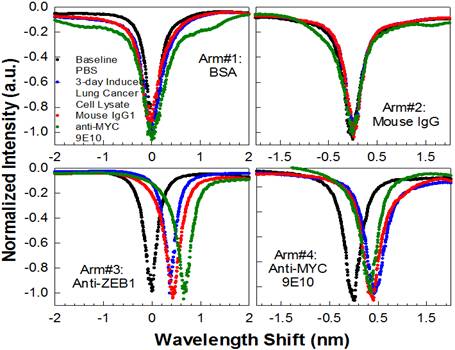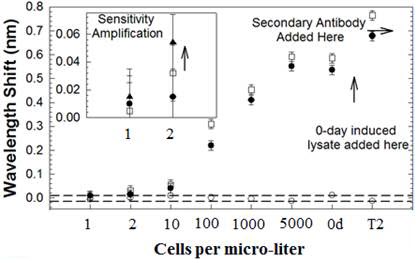HIGH THROUGHPUT MULTIPLEXED DETECTION OF LUNG CANCER CELL LINE LYSATES
Our first generation devices will multiplex 64 and 128 sensors on a silicon chip for simultnaeous detection of specific and control binding reactions between a probe protein and its conjugate pair. Proof-of-concept demonstrated experimentally with 4 sensors, including 2 specific and 2 control antibodies, for the detection of NCI-H358 lung cancer cell line lysates

Representative Publication: Swapnajit Chakravarty, Wei-Cheng Lai, Yi Zou, Harry A. Drabkin, Robert M. Gemmill, George R. Simon, Steve H. Chin, Ray T. Chen, Multiplexed specific label-free detection of NCI-H358 lung cancer cell line lysates with silicon based photonic crystal microcavity biosensors, Biosensors and Bioelectronics 43, 50-55 (2013).
SANDWICH ASSAY FOR AMPLIFICATION AND SPECIFICITY
Within the multiplexed assay, we simultaneously demonstrated detection with specificity using sandwich assay methods. Sandwich amplification allowed detection sensitivity down to 2 cells per microliter compared to 10 cells per micro-liter without sandwich.

Representative Publication: Swapnajit Chakravarty, Wei-Cheng Lai, Yi Zou, Harry A. Drabkin, Robert M. Gemmill, George R. Simon, Steve H. Chin, Ray T. Chen, Multiplexed specific label-free detection of NCI-H358 lung cancer cell line lysates with silicon based photonic crystal microcavity biosensors, Biosensors and Bioelectronics 43, 50-55 (2013).
HIGHEST SENSITIVITY AMONG ALL CHIP-BASED OPTICAL BIOSENSORS
Detection sensitivity down to 50 femto-molar has been experimentally demonstrated.
Representative Publication: Yi Zou, Swapnajit Chakravarty, Wei-Cheng Lai, Cheng-Chih Hsieh, Ray T. Chen; High yield silicon photonic crystal microcavity biosensors with 100fM detection limit, Proc. of the SPIE 8570, 857008 (2013);
Highest sensitivity amongst all chip-based optical techniques on smallest dimensions.

Representative Publication: Swapnajit Chakravarty, Yi Zou, Wei-Cheng Lai and Ray T. Chen, Slow light engineering for high Q high sensitivity photonic crystal microcavity biosensors in silicon, Biosensors and Bioelectronics 38, 170-176(2012).
The program is supported by a SBIR contract from the National Cancer Institute